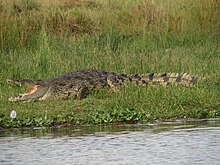Neosuchia
| Neosuchia Temporal range: Early Jurassic - Recent, | |
|---|---|
 | |
| Crocodylus niloticus, a modern crocodylid | |
 | |
| Sarcosuchus imperator, a pholidosaurid from North Africa in the Early Cretaceous | |
| Scientific classification | |
| Domain: | Eukaryota |
| Kingdom: | Animalia |
| Phylum: | Chordata |
| Class: | Reptilia |
| Clade: | Archosauria |
| Clade: | Pseudosuchia |
| Clade: | Crocodylomorpha |
| Clade: | Crocodyliformes |
| Clade: | Metasuchia |
| Clade: | Neosuchia |
| Subgroups | |
Neosuchia is a clade within Mesoeucrocodylia that includes all modern extant crocodilians and their closest fossil relatives.[1] It is defined as the most inclusive clade containing all crocodylomorphs more closely related to Crocodylus niloticus (the Nile Crocodile) than to Notosuchus terrestris.[2] Members of Neosuchia generally share a crocodilian-like bodyform adapted to freshwater aquatic life, as opposed to the terrestrial habits of more basal crocodylomorph groups.[3] The earliest neosuchian is suggested to be the Early Jurassic Calsoyasuchus, which lived during the Sinemurian and Pliensbachian stages in North America. It is often identified as a member of Goniopholididae,[4] though this is disputed, and the taxon may lie outside Neosuchia, which places the earliest records of the group in the Middle Jurassic.[3]
Characteristics[edit]
A tooth notch between the maxilla and premaxilla is a basal characteristic of the Neosuchia, although it is lost in some more derived forms, most notably alligatorids.
Classification[edit]
- Basal Neosuchia
- Genus Burkesuchus?
- Genus Deltasuchus
- Genus Khoratosuchus
- Genus Lisboasaurus
- Genus Paluxysuchus
- Genus Stolokrosuchus
- Genus Wahasuchus?
- Family Susisuchidae
- Clade Coelognathosuchia
- Family Goniopholididae
- ?Family Pholidosauridae
- Suborder Tethysuchia
- Family Elosuchidae
- Family Dyrosauridae
- Family Pholidosauridae
- Family Stomatosuchidae
- Family Bernissartiidae
- Genus Gilchristosuchus
- Suborder Eusuchia
Phylogeny[edit]
Below is a cladogram showing the phylogenetic relationships of neosuchians from Buscalioni et al., 2011:[5]
| Neosuchia |
| ||||||||||||||||||||||||||||||
In 2012, paleontologists Mario Bronzati, Felipe Chinaglia Montefeltro, and Max C. Langer conducted a broad phylogenetic analysis to produce supertrees of Crocodyliformes, including 184 species. The most parsimonious trees were highly resolved, meaning the phylogenetic relationships found in the analysis were highly likely. Below is a consensus tree from the study:[6]
| Neosuchia |
| ||||||||||||||||||||||||||||||||||||||||||||||||||||||
See also[edit]
References[edit]
- ^ Wilson, J. A.; Malkani, M. S.; Gingerich, P. D. (2001). "New crocodyliform (Reptilia, Mesoeucrocodylia) from the Upper Cretaceous Pab Formation of Vitakri, Balochistan (Pakistan)" (PDF). Contributions from the Museum of Paleontology, University of Michigan. 30 (12): 321–336. Retrieved 2009-11-02.
- ^ Larsson, H. C. E.; Sidor, C. A.; Gado, B.; Gado, B (2001). "The giant crocodyliform Sarcosuchus from the Cretaceous of Africa" (PDF). Science. 294 (5546): 1516–1519. doi:10.1126/science.1066521. PMID 11679634. S2CID 22956704. Retrieved 2009-11-02.
- ^ a b Wilberg, Eric W.; Turner, Alan H.; Brochu, Christopher A. (2019-01-24). "Evolutionary structure and timing of major habitat shifts in Crocodylomorpha". Scientific Reports. 9 (1): 514. Bibcode:2019NatSR...9..514W. doi:10.1038/s41598-018-36795-1. ISSN 2045-2322. PMC 6346023. PMID 30679529.
- ^ Tykoski, R. S.; Rowe, T. B.; Ketcham, R. A.; Colbert, M. W. (2002). "Calsoyasuchus valliceps, a new crocodyliform from the Early Jurassic Kayenta Formation of Arizona" (PDF). Journal of Vertebrate Paleontology. 22 (3): 593–611. doi:10.1671/0272-4634(2002)022[0593:CVANCF]2.0.CO;2. Retrieved 2009-11-02.
- ^ Buscalioni, A.D.; Piras, P.; Vullo, R.; Signore, M.; Barbera, C. (2011). "Early eusuchia crocodylomorpha from the vertebrate-rich Plattenkalk of Pietraroia (Lower Albian, southern Apennines, Italy)". Zoological Journal of the Linnean Society. 163: S199–S227. doi:10.1111/j.1096-3642.2011.00718.x.
- ^ Bronzati, M.; Montefeltro, F. C.; Langer, M. C. (2012). "A species-level supertree of Crocodyliformes". Historical Biology. 24 (6): 598–606. doi:10.1080/08912963.2012.662680. S2CID 53412111.
External links[edit]
- Neosuchia in the Paleobiology Database


 French
French Deutsch
Deutsch


